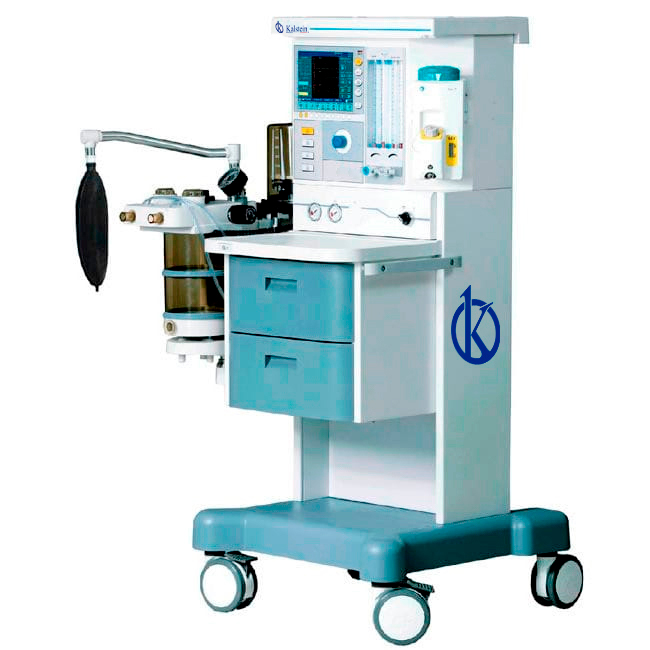This machine is undoubtedly an indispensable piece of equipment in healthcare centers, clinics and hospitals, mainly in surgical and patient recovery areas, thanks to technological advances these anesthesia machines offer safety to patients, it is used in most procedures that need to administer anesthetic gases to patients, in addition to taking a monitored control of breathing and stable state during the medical process.
This workstation has a complex structure of several components, such as: vaporizers, ventilators, breathing systems, scanning systems and monitors, which are integrated are necessary for the general anesthesia process; in addition, it is capable of performing other processes if you integrate additional elements such as drug administration, suction equipment and data management; although all these components that make it up make it a complex machine, its function is quite simple.
Anesthesia machine functions
The functions of the anesthesia machine are fairly straightforward, and this equipment is directly linked to the operative surgical processes, but we can list just a few of its functions:
- Administer anesthesia
- Control its depth.
- Manage the patient’s breathing completely.
- Monitor all respiratory variables.
- Monitor own functioning.
- Incorporate other forms of monitoring of various parameters necessary to control during general anesthesia: hemodynamics, temperature, neuromuscular transmission, EEG, among others.
At present, due to the emergence of COVID-19, anesthesia machines have been given an alternative, FDA-approved use, namely as ICU (intensive care unit) ventilators, but it is recommended to return to the original use of these machines as soon as possible in order to avoid malfunctions and keep the risk to the patient to acceptable levels, by preventing their malfunction.
Main features of anesthesia machines
Given that these devices must ensure the supply of an exact quantity of gas so as not to compromise the patient’s health, we need to choose an anaesthesia machine that satisfactorily covers most of its functions, such as the ability to monitor the patient’s condition and fully ensure the functionality of general anaesthesia, so an anaesthesia machine must have the following main features:
- A source of O2 (dioxygen or oxygen gas) and a form of CO2 elimination.
- A source of liquids or gases for anesthesia.
- An inhalation system (cylinders, yokes, valves, flowmeters, manometers, etc.).
Advantages of using KALSTEIN anesthesia machines
The advantage of our products is that they are made from the finest, high-quality materials, in this case the KALSTEIN YR anesthesia machine, provides an affordable and flexible anesthesia solution for now and the future; use can start with a routine application, however, it can be upgraded to better meet patients’ anesthetic requirements. It is also possible to extend this equipment on modern KALSTEIN anesthesia workstations to significantly improve workflow and reduce operating costs.
Among the functional advantages offered by these KALSTEIN YR machines, we should mention a number of features that favour their use, such as :
- The anesthesia machine features an electronic PEEP function.
- It has automatic tidal volume compensation.
- It provides a high-precision output of just 20 ml.
- The anesthesia machine uses autoclavable, latex-free components.
- It can be easily maintained and cleaned without specialized tools.
- It is CE certified, offering peace of mind to users.
In general, YR anesthesia machine applications can be used for the administration of inhalation anesthesia in adult, pediatric and neonatal patients, more information HERE
How an anesthesia machine works
As already described, the anesthesia machine is primarily used to deliver anesthetic serums to the patient, then the machine receives medicinal gases and precisely distributes the flow and pressure of each gas according to the patient’s needs, so if a patient requires a high concentration of certain gases, this need can also be matched to the machine’s operation.
Another function of the anesthesia machine is that it works to monitor the patient’s vital signs and works on any functions that the patient cannot perform due to general anesthesia, functions such as breathing, since the diaphragm and chest muscles are completely relaxed under the effects of anesthesia; then a positive pressure gradient is introduced into the patient’s lungs, with oxygenated air, then allows carbon dioxide to escape, so, they can also be converted into ventilators. But its function goes beyond the simple contraction and expansion of the thoracic cavity.
Visit our website, we guarantee you an interesting visit through the range of products we have at KALSTEIN for you, you’ll be able to ask for technical service, we assure you that through our online buy-sell channels you’ll have the best options, enter the following link: HERE we remind you that we are manufacturer of high level laboratory equipment.

